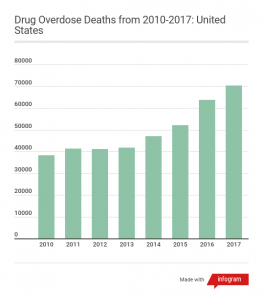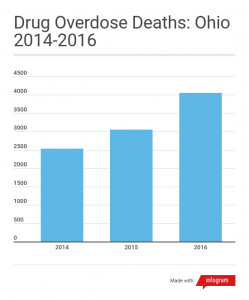
Breaking the Cycle of Drug Abuse
By: Brook Endale, Brooke Davis, Nate Buccilla
Posted on:

The opioid epidemic has devastated communities throughout Ohio and the nation and it is tearing families apart. The situation has gotten so drastic that the White House declared it a health emergency.
Drug addiction is not a new fight in this country and the numbers show it’s a fight we’ve been losing. Since 2000, there has been a 230% increase in overdose deaths.
Ohio is one of the states hit hardest by the opioid epidemic, with drug-related deaths triple the national average.
With no solution to this crisis in sight, experts are saying it’s time we change how we approach drug addiction and treatment on a national level.
Trauma Informed Care

“I don’t think we’ve done a good job of recognizing it isn’t just the opioids, it’s a much deeper societal issue going on here,” said Ron Luce, executive director of the John W. Clem House Recovery House.
The Clem House is a men’s rehabilitation center that uses a trauma-informed care approach when addressing addiction. Trauma-informed care is a treatment framework that aims to recognize and respond to trauma with psychological and emotional care.
Luce thinks this approach is important because a lot of the men who come to the Clem House suffer from childhood trauma.
“I can’t tell you the number of men that have told me they were sexually abused as children or mom and dad were doing drugs, they’d watch the parents overdose, maybe die,” said Luce.
After hearing the men’s stories, Luce understands the extent of the pain they’ve experienced in their lives.
“When you start a child out in that situation, you are almost begging them to deal with some form of pain and many times they self-medicate.”

Growing up in a bad environment can lead a person to drug abuse, explains Brian Yates, a resident at Clem House.
The group of friends he grew up with experimented with drugs and pressured him to begin using. He developed an addiction to crack that he spent years fighting as it took a toll on his life.
“The monster that got me was crack. I lost everything because of crack,” Yates said.
His daughter is currently battling addiction as well, she’s now about 80 days clean from heroin.
There is a cyclical pattern with drug abuse, it never affects just the addict but their loved ones as well.
A Mental Health Crisis
Nancy Bower, a clinical coordinator at Bassett House Recovery Center, sees firsthand how drug abuse can turn into a vicious, inter-generational cycle. She works with teenagers ages 13 to 19 struggling with addiction.
“The cycle sometimes starts with the parents introducing the kids to the drugs because the parents don’t want to get in trouble, so if the kids are also using then they can’t rat out the parents,” said Bower.
She believes the drug epidemic we’re seeing now is a direct result of a mental health crisis facing this country. Bower spends a lot of time telling state representatives that expanding mental health care is necessary to end the opioid epidemic.
“It’s more of a mental health crisis to me than an opioid crisis,” said Bower. “What’s taking most lives is the fentanyl but these days it’s also kids huffing duster, you know sudden inhalation death syndrome… and it’s about figuring out why did they do that.”

It’s a pattern she’s noticed over the span of her career; when one drug gets pushed out, another just takes its place. That is why she focuses on treating what led the kids to drugs in the first place, and often, it can be traced to their environment.
“It’s just pretty horrific conditions…houses full of people who do drugs, no running water, no electric,” Bower said recounting what she sees on home visits.
“They have to pretty much live off the food they get at school and if they don’t go to school, they have to scam,” she said.
Luce has also noticed a cycle of abuse when it comes to addiction.
“Children experiencing trauma that is untreated will result in problems when they are adults, that’s all there is to it,” Luce said.
Strain on Foster System
Chelsea Schott is a foster mom who takes care of some of the youngest victims of the opioid epidemic.
Some of the babies in her care were born with neonatal abstinence syndr ome, a condition that causes birth defects, seizures and stunted growth. A lot of the toddlers in her care also deal with emotional trauma.
ome, a condition that causes birth defects, seizures and stunted growth. A lot of the toddlers in her care also deal with emotional trauma.
She told the story a young boy, age four, who was abandoned by his parents and went through six foster homes within a year.
“I mean you can just imagine the gamut of issues he had…he wasn’t potty trained, he had some medical issues that needed to be addressed,” said Schott. “He needed therapy, he was just badly damaged.”
Stories like that are not uncommon as drug overdoses and addiction are leaving so many children in foster care.
Barbara Cline, a quality assurance supervisor at Athens County Children Services, said a tremendous strain has been placed on the foster care system as a result of the opioid epidemic. She is seeing an increase in kids that need more specialized mental care due to the trauma they have faced.
“Like 3 or 4-year-old can tell you about the process to take drugs… they’ll be like ‘Mommy is sick, so she put a needle in’ or ‘mommy took this and she was sleepy,” said Cline.
Cline believes there needs to be a change in how addiction treatment is approached to help both parents and their children heal.
“We are trying to become more of a trauma-informed agency to understand all of the bad things that make people want to go towards drugs and what the addiction is and what we can do to assist them,” Cline said.
The Cycle of Abuse
Athens High School Assistant Principal, Chad Springer, sees how children who live in homes where drug abuse is present suffer emotionally from the lack of stability in their lives.
“You watch a kid leave and they had a great day here and they go home, and it’s scary what they go home to,” Springer said.
Physical and verbal abuse are prevalent in these homes so Springer tries to understand what triggers his students have and shapes his education and disciplinary style accordingly. This is a form of trauma-informed care.
Springer tries his best to intervene at school but knows due to the nature of drug addiction, more needs to be done.
“It’s cyclic… they experienced abuse and they abuse drugs and alcohol to cope with it later on in life. Springer said.
An increasing number of rehabilitation centers are opting for trauma-informed care treatments. They understand addiction doesn’t affect only the addict but takes a toll on their loved ones as well.
There are a myriad of factors that fuel drug abuse including lack of mental health resources, domestic abuse and poverty. Without addressing those factors, addiction will continue to be a national epidemic.
“First of all, we need to recognize it isn’t so much the drug is the issue,” said Luce. “I think people need a sense of self-worth, a sense of future, and a sense of hope and I think a lot of that is disappearing from the landscape.”

